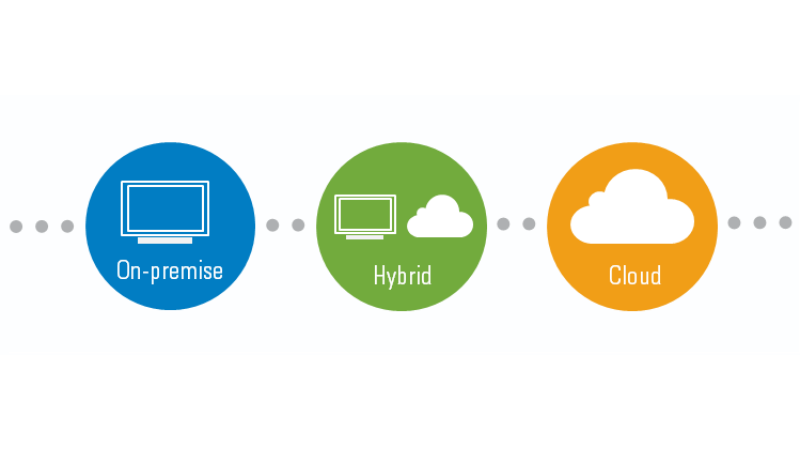Cloud deployment models can be segregated into three types: Public Cloud, Private Cloud/On-Premise Infrastructure and Hybrid Cloud.
Ten years ago, companies around the world typically built and managed their own IT infrastructures. Since it was run by the companies themselves, the term on-premise was coined. But, today the world has moved on from the on-premise deployment model towards highly robust and scalable public cloud and hybrid cloud models.
To put it simply, a hybrid cloud is when you connect your existing on-premise infrastructure to the cloud. By integrating your on-premise resource with cloud resources, you can get the benefits of both worlds. You can have dedicated resources supplied by your on-premise infrastructure, while the connection to cloud will allow you scale things as and when it’s necessary, and enjoy other cloud-specific benefits as well.
To explain how this works at its most basic level, let’s take a hypothetical big box retailer named Cost-Mart who’s been around for a while, say fifty years.
Since they have been in the business for the last five decades, they necessarily have the IT infrastructure to support their business. Their growing e-commerce business is stretching their infrastructure to the limit, but moving the legacy system into a public cloud is not something that they can do overnight. Besides, Cost-Mart is not even sure if it wants to depend on third parties to host its servers. They believe their own infrastructure is capable enough to handle their requirements, but they need some extra support to handle seasonal spikes in e-commerce sales volume. The best solution in such a case would, naturally, be hybrid cloud.
Cost-Mart can connect their on-premise infrastructure to a cloud, and scale up to handle sudden surges in demand during peak season. What’s more important is that they can scale things back when demand returns to normalcy.
There are several benefits to such a system: the company doesn’t have to abandon the billions of dollars invested in its own datacenters and software, and it retains the bulk of archived data on its own properties, yet it can leverage the elasticity and additional resources of cloud computing, cloud infrastructure, a development platform, additional software and much more.
What the hybrid cloud model does is allow the company to retain control over its own software and hardware resources, which is critical for most big enterprises. By choosing a third-party hybrid cloud solutions provider – such as IBM or Microsoft, for example – the company enjoys a close partnership of sorts.
That said, partnerships aren’t necessarily a good thing. One point to note is that a hybrid cloud partnership is much easier to break off than a public cloud one.
Let me elaborate…
Take the recent spat between Walmart Canada and Visa as an ideal example. The companies were fighting over how much extra margin they can get from the other. Walmart initially banned the acceptance of Visa in its Canadian stores, and has only lifted the ban a few days ago.
“Walmart claims the fees Visa charges the retailer to process payments are too high, saying it pays more than $100 million a year in such charges and wants that number lowered. Visa, meanwhile, counters that Walmart already gets some of the lowest fees it has offered to any retailer in Canada.” – CBC
That partnership was resolved amicably, for the most part, but in a public cloud scenario it would put the customer at the mercy of the cloud provider. Imagine if a company as big as Wal-Mart had all its infrastructure on public cloud with Amazon or Microsoft. What would happen if that relationship broke down over pricing issues?
The first thing that would happen is that Wal-Mart would find itself in a fix. Moving out of a public cloud when you have most of your digital assets there is extremely difficult at that scale. Not only would Wal-Mart need to first build out its own infrastructure from scratch, but it would take years for the move to be completed.
That risk is something most large companies are unwilling to take, and why should they? For example, why should a company with several petabytes of archived and live data move to a public cloud where it would practically be locked in for life? It just doesn’t make sense.
And that’s where the logic of hybrid cloud wins over any other model – both an on-premise one as well as a public cloud solution. With a hybrid model, the customer retains control over core assets and outsources everything else that is infrastructure-intensive. It’s the perfect blend of on-premise and public cloud.
It’s no surprise then, that a recent North Bridge and Wikibon report showed that 47% of companies are opting for a hybrid model over pure public cloud. And the one company that’s been pitching hybrid to its clients from the beginning has been IBM.
RELATED: How IBM Predicted the Dominance of Hybrid Cloud
Ideally, though, enterprise companies should be looking at a multi-vendor hybrid model to make sure they don’t have all their eggs in one basket. It’s the same idea as a retailer accepting several brands of credit cards. If Wal-Mart didn’t have any option other than Visa at their Canada units, they would never have been able to stop accepting the cards no matter how badly they wanted to negotiate a price cut.
As we get deeper into cloud discussions, we’ll bring you the best and worst of the various cloud deployment models, what their real costs are and how they can benefit different types of companies in their own unique ways.
Thanks for reading our work! We invite you to check out our Essentials of Cloud Computing page, which covers the basics of cloud computing, its components, various deployment models, historical, current and forecast data for the cloud computing industry, and even a glossary of cloud computing terms.



